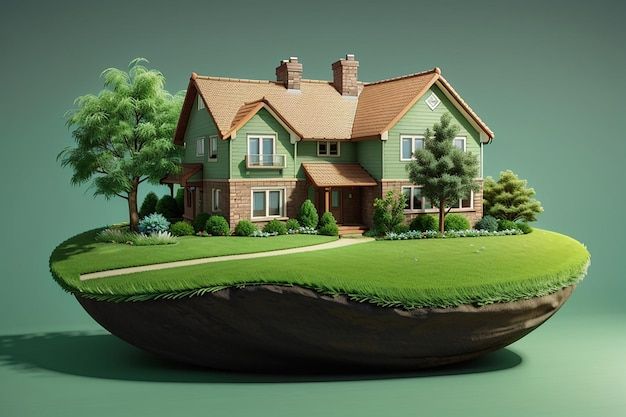
In today’s world, where climate change and sustainability are at the forefront of global discussions, the real estate industry is undergoing a powerful transformation. Eco-friendly homes—once a niche concept—are now driving demand, reshaping buyer expectations, and influencing property values. From energy efficiency to renewable materials, green living isn’t just a lifestyle trend—it’s a movement that’s changing how we build, buy, and sell homes.
In this blog post, we explore what defines an eco-friendly home, the benefits of green living, and how it’s revolutionizing real estate for homeowners, investors, and developers alike.
What Is a Green or Eco-Friendly Home?
An eco-friendly home is designed and built with the environment in mind. It minimizes energy consumption, reduces waste, and makes use of sustainable, non-toxic, and renewable resources. But green homes aren’t just about saving the planet—they’re also about improving the quality of life for residents.
Key features of eco-friendly homes include:
- Energy-efficient appliances and lighting
- Solar panels and renewable energy systems
- Insulated walls, windows, and roofing to regulate temperature
- Smart thermostats and automation systems
- Low-flow toilets, faucets, and water recycling systems
- Sustainable building materials (e.g., bamboo, reclaimed wood, recycled steel)
- Non-toxic paints and finishes
- Landscape designs that support local biodiversity and reduce water usage
How Green Living Is Changing Real Estate
The rise of eco-conscious consumers is shifting the real estate landscape in significant ways. Here’s how:
1. Increased Buyer Demand for Green Homes
Today’s homebuyers, particularly millennials and Gen Z, are looking for properties that align with their values—sustainability, wellness, and energy savings. A study by the National Association of Home Builders found that over 80% of buyers consider energy efficiency to be a key factor when choosing a home.
Bottom Line: Homes with green certifications and sustainable features sell faster and often at a premium.
2. Impact on Property Values
Energy-efficient upgrades can directly influence a property’s value. According to research, homes with solar panels, energy-efficient windows, and green certifications (like LEED, ENERGY STAR, or Green Globes) tend to appraise higher than similar homes without these features.
Bonus: In many areas, governments offer tax credits and incentives for homes that meet green standards—making them even more attractive to buyers.
3. Lower Utility Costs for Owners and Tenants
Eco-friendly homes are designed to use less water and energy, which translates to lower monthly utility bills. This long-term cost-saving is a significant selling point for renters and buyers alike.
Example: A home equipped with solar panels and proper insulation can save hundreds to thousands of dollars annually on electricity.
4. Shift in Developer and Investor Priorities
Real estate developers are increasingly incorporating sustainable design into new builds, knowing it attracts forward-thinking buyers and investors. Green building isn’t just good for the planet—it’s good business.
Market Trends:
- Green building market is projected to reach over $1 trillion globally by 2030.
- Many real estate investment trusts (REITs) now prioritize sustainable portfolios.
5. Health and Wellness as Selling Points
Green homes don’t just reduce environmental impact—they also promote better indoor air quality and a healthier living environment. Non-toxic paints, proper ventilation, and natural light all contribute to a healthier space, which is increasingly valued in the post-pandemic world.
Result: “Wellness real estate” is emerging as a powerful niche that blends health and sustainability.
How to Make a Home More Eco-Friendly
You don’t need to build from scratch to enjoy the benefits of green living. Here are simple upgrades that can boost sustainability:
- Replace old light bulbs with LED alternatives
- Install low-flow showerheads and dual-flush toilets
- Upgrade to Energy Star-rated appliances
- Add solar panels or a solar water heater
- Use programmable or smart thermostats
- Choose sustainable flooring like bamboo or cork
- Add insulation to attics and walls
- Install rainwater harvesting systems or greywater recycling
Certifications and Green Standards to Know
When buying or selling eco-friendly homes, look for these certifications:
- LEED (Leadership in Energy and Environmental Design)
- ENERGY STAR (energy efficiency for appliances and homes)
- Green Globes
- WELL Building Standard (focuses on health and wellness)
- BREEAM (Building Research Establishment Environmental Assessment Method)
These labels not only confirm environmental performance but can also increase market appeal.
The Future of Green Real Estate
Green living is no longer just a personal choice—it’s becoming an industry standard. As energy costs rise and climate concerns grow, sustainable homes are poised to dominate the market. Technological innovations like solar roofing, smart grids, and AI-driven energy management systems will make it easier and more affordable for everyone to live green.
Expect to see:
- More eco-friendly developments and smart cities
- Mandatory energy ratings for property listings
- Sustainability becoming a key value proposition in real estate marketing
Final Thoughts
Eco-friendly homes represent the future of real estate. They offer tangible benefits—lower costs, healthier living, and environmental responsibility—while meeting the evolving expectations of modern buyers. Whether you’re a homeowner, real estate agent, or property investor, going green is not just good ethics—it’s smart business.
As awareness continues to grow, embracing green living today could be the best investment in tomorrow.
